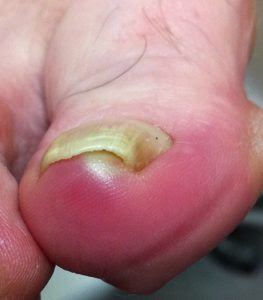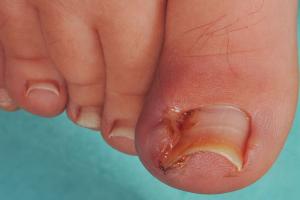
Symptoms
- Pain and tenderness along the edge of the nail.
- Redness and swelling around the nail.
- Possible infection:
1. Pus or drainage.
2. Increased redness or warmth.
- Difficulty walking or wearing shoes due to discomfort.
Treatment Options
Home Care for Mild Cases
1. Warm Soaks:
- Soak the foot in warm water with Epsom salt for 15-20 minutes, 2-3 times a day, to reduce swelling and soften the skin.
2. Proper Nail Care:
- Trim the nail straight across and avoid rounding the edges.
3. Lift the Nail:
- Place a small piece of sterile cotton or dental floss under the ingrown edge to guide the nail to grow away from the skin.
4. Pain Relief:
- Over-the-counter pain relievers like ibuprofen or acetaminophen.
5. Topical Antibiotics:
- Apply antibiotic ointment (e.g., Neosporin) to prevent infection.
Preventing Ingrown Toenails
1. Trim Nails Properly:
- Cut nails straight across, and avoid cutting them too short.
2. Wear Comfortable Footwear:
- Choose shoes with a wide toe box to prevent pressure on the nails.
3. Practice Good Foot Hygiene:
- Keep feet clean and dry.
4. Protect Your Toes:
- Avoid trauma by wearing protective footwear during activities.
5. Address Foot Abnormalities:
- Use orthotics or padding for foot deformities that contribute to pressure on the nails.
